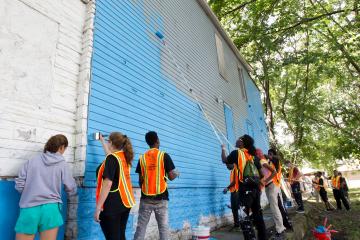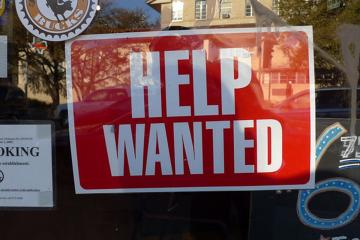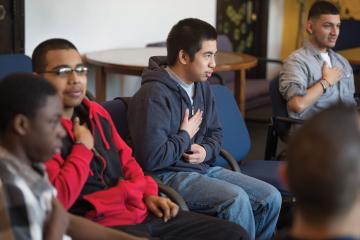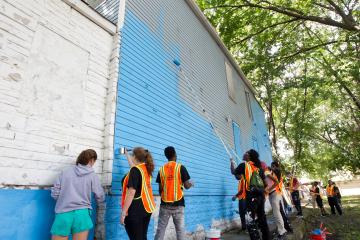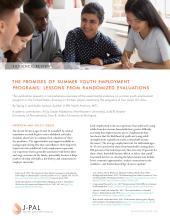The Promises of Summer Youth Employment Programs: Lessons from Randomized Evaluations
Summer youth employment programs are an evidence-based option for improving the lives of young people in outcome areas as diverse as criminal justice involvement, education, and youth development.
Introduction
Early employment experiences can offer young adults vital opportunities for personal growth as well as a chance to establish foundational skills for the working world. Unfortunately, youth from low-income households are more likely to face challenges entering the labor market and to be unemployed than peers from higher-income households. Policymakers can use summer youth employment programs (SYEPs) to help youth to access positive early employment experiences. SYEPs are municipal programs that provide qualifying youth and young adults ages 14 to 24, often from households with low incomes, with a paid, part-time job and related supplemental services during the summer months. Rigorous research discussed throughout this evidence review shows that participating in an SYEP can have many benefits for youth both during and beyond the summer. As policymakers strive to find ways to support youth in the wake of the Covid-19 pandemic, summer youth employment programs are an evidence-based option with the potential to improve the lives of young people in outcome areas as diverse as employment and earnings, criminal justice involvement (rates of arrest, arraignments, and probability of conviction and incarceration), education, and youth development.
J-PAL North America’s SYEP evidence review presents findings from thirteen randomized evaluations of programs across four major US cities and highlights key takeaways for policymakers. More information on each of the thirteen studies and the SYEPs evaluated can be found in Appendix A of the evidence review and in the studies cited at the end of this page.
The 2021 American Rescue Plan (ARP) Act includes SYEP as an example of programs eligible to receive Covid-19 pandemic recovery funds, including from both the State and Local Fiscal Recovery Funds and the Elementary and Secondary School Emergency Relief (ESSER) Fund. The Biden-Harris Administration has specifically called on state and local governments to invest in SYEPs using ARP funds as part of its Comprehensive Strategy to Prevent and Respond to Gun Crime and Ensure Public Safety.
The evidence
SYEPs provide employment and boost earnings for youth who may otherwise have difficulty finding summer employment.
SYEPs disproportionately serve youth from low-income households or who identify as Black or Hispanic, groups that typically face higher than average barriers to entering the labor market.
SYEPs consistently reduce involvement in the criminal justice system for participating youth for the duration of the program and at least a year beyond.
Researchers observed that programs reduced arrests, arraignments, convictions, and/or incarcerations across four cities, with evidence pointing to both contemporaneous and post-program effects.
Youth at greater risk of experiencing socially costly outcomes, such as involvement with the criminal justice system or disengagement from school, are shown to experience the greatest benefits from SYEPs.
This does not mean that every youth facing difficult circumstances benefited, but rather that when the program prevented socially costly outcomes, the biggest changes were among those who experienced the greatest risk of those outcomes.
For the most part, SYEPs do not increase rates of formal sector employment for the average participant after the program ends, with some exceptions.
Some subsets of participants may experience small benefits compared to the average participant. Emerging research suggests that adding post-program job search resources may also improve longer-term employment outcomes.
The evidence on SYEPs’ role in improving educational outcomes is mixed.
On average, in the studies that showed positive effects in academic outcomes, those who benefited were youth of legal drop-out age and youth who had a higher rate of school absences prior to program participation.
There is promising evidence that SYEPs have positive effects on a range of youth development outcomes.
These outcomes include social-emotional skills, academic and career aspirations, and work habits associated with job readiness.
Listen: Summer youth employment in action
J-PAL Voices: The Impact and Promise of Summer Jobs in the United States
This podcast from J-PAL North America brings to life the stories behind the numbers. Hear from advocates and program coordinators, researchers, and most importantly, participants themselves about why summer jobs programs matter to them and why they should matter for all of us.
Check out the podcast on its webpage, or wherever you get your podcasts.
Policy recommendations
Localities interested in reducing young people’s contact with the criminal justice system should consider additional investments in SYEPs.
The research examined in our SYEP evidence review shows that SYEPs consistently reduce arrests, arraignments, convictions, and incarcerations for the populations they serve. Youth involved in the juvenile and criminal justice systems tend to face increased barriers to completing high school and are more likely to be incarcerated as adults.1 Few programs have been so successful in reducing not only initial contact with the criminal justice system at the point of arrest, but also additional points throughout the pipeline of involvement with the court system. By successfully leveraging connections with local community organizations and businesses, SYEPs help youth and young adults access positive experiences that can help them succeed and stay safe both during and beyond the program summer.
Adapting eligibility standards and recruitment to focus on specific groups may change overall program impact across different outcome areas.
The full picture of SYEPs’ effects on youth outcomes is complex, with different groups experiencing greater benefits in some outcomes as compared to others. In circumstances where funding may not be available to offer every interested youth a slot in the program, policymakers may consider focusing on specific participant populations. They should use the research available to help determine how adapting eligibility requirements and recruitment strategies might help them achieve different policy priorities.
Program models vary in the types of supplemental services they offer, but providing jobs with committed, growth-oriented employers is the foundational component.
For most outcome areas, there is not enough research to determine how the supplementary support or enrichment components frequently offered by SYEPs contribute to program effects. For criminal justice outcomes, the consistency at which SYEPs reduce criminal justice system involvement despite variation in the type of services different programs offer suggests that supplemental services are not the main driver of impact. Given the current evidence, jurisdictions lacking the resources to include additional supports in their SYEP model may still be able to reduce participants' involvement with the criminal justice system by focusing on providing jobs with committed partner employers.
SYEPs represent an opportunity to create a stronger social safety net for households with low incomes.
SYEPs primarily serve youth from households with low incomes and the evidence shows that they significantly boost the earnings of participants. Surveys suggest that participants often use these wages to support their families, which means SYEPs may provide a new avenue for increasing the financial resources of low-income households.
Media and resources
Mayor de Blasio, Bring Back Summer Jobs
Stopping a Bullet with a Summer Job
Can Summer Jobs Reduce Violent Crime?

More jobs, less crime
Can Chicago Fight Violence with Summer Jobs?
How summer jobs can help save lives
Another Chance for Teens
Dive into the evidence
Evaluation summaries
- The Effects of Youth Employment: Evidence from New York City Summer Youth Emplo…
- Scaling and Unpacking a Successful Summer Jobs Program
- Summer Jobs Reduce Violence Among Youth Facing Barriers to Opportunity in the U…
- Understanding the Potential of Summer Jobs Programs for Youth in Philadelphia
- Summer Jobs Improve Employment Outcomes for Connected Youth
- How Boston’s Summer Employment Program Affects Youth Criminal Justice Outcomes
- Letters of Recommendation for Youth Employment in the United States
Policy products
Partner with J-PAL North America
Summer youth employment programs have a strong evidence base that shows great promise for continued research into new program models. J-PAL North America welcomes inquiries from community leaders, government agencies, summer youth employment programs, or other organizations interested in evaluating a summer jobs program or implementing summer youth employment programs at scale.
Footnotes
-
Aizer, Anna and Joseph J. Doyle. 2015. “Juvenile Incarceration, Human Capital and Future Crime: Evidence from Randomly-Assigned Judges.” The Quarterly Journal of Economics 130, no. 2 (May): pp. 759–804. doi: https://doi.org/10.1093/qje/qjv003
Summer youth employment program evaluations
-
Davis, Jonathan M.V., and Sara B. Heller. 2020. “Rethinking the Benefits of Youth Employment Programs: The Heterogeneous Effects of Summer Jobs.” The Review of Economics and Statistics 102, no. 4 (October): 664-677. doi: https://doi.org/10.1162/rest_a_00850.
-
Gelber, Alexander, Adam Isen, and Judd B. Kessler. 2016. "The Effects of Youth Employment: Evidence from New York City Lotteries." Quarterly Journal of Economics 131, no. 1 (February): 423-460. doi: https://doi.org/10.1093/qje/qjv034.
-
Heller, Sara B. 2014. "Summer Jobs Reduce Violence Among Disadvantaged Youth." Science 346, no. 6214 (December): 1219-1223. doi: https://doi.org/10.1126/science.1257809.
-
Heller, Sara B. 2022. “When Scale and Replication Work: Learning from Summer Youth Employment Experiments.” Journal of Public Economics 209 (May): 104617. doi: https://doi.org/10.1016/j.jpubeco.2022.104617.
-
Heller, Sara B. and Judd B. Kessler. “The Effects of Letters of Recommendation in the Youth Labor Market.” NBER Working Paper #29579, December 2021. doi: https://doi.org/10.3386/w29579.
-
Kessler, Judd B., Sarah Tahamont, Alexander M. Gelber, and Adam Isen. 2021. "The Effects of Youth Employment on Crime: Evidence from New York City Lotteries." NBER Working Paper #28373, January 2021. doi: https://doi.org/10.3386/w28373
-
Leos-Urbel, Jacob. 2014. “What is a Summer Job Worth? The Impact of Summer Youth Employment on Academic Outcomes.” Journal of Policy Analysis and Management 33, no. 4 (July): 891-911. doi: https://doi.org/10.1002/pam.21780.
-
Mayor’s Office of Workplace Development and Alicia Sasser Modestino. 2017. “Reducing Inequality Summer by Summer: An Analysis of the Short-term and Long-term Effects of Boston’s Summer Youth Employment Program.” Mayor’s Office of Workplace Development. December 2017. https://owd.boston.gov/wp-content/uploads/2017/12/SYEP-Report-FINAL-12.12.17.pdf.
-
Modestino, Alicia Sasser. 2019. “How Do Summer Youth Employment Programs Improve Criminal Justice Outcomes, and for Whom?” Journal of Public Policy Analysis and Management 38, no. 3 (April): 600-628. doi: https://doi.org/10.1002/pam.22138.
-
Modestino, Alicia Sasser and Richard J. Paulsen. 2019. “Reducing Inequality Summer by Summer: Lessons From an Evaluation of the Boston Summer Youth Employment Program.” Evaluation and Program Planning 72 (April): 40–53. doi: https://doi.org/10.1016/j.evalprogplan.2018.09.006.
-
Modestino, Alicia Sasser, and Richard Paulsen. 2022. "School's Out: How Summer Youth Employment Programs Impact Academic Outcomes." Education Finance and Policy. Published ahead of print, January 3, 2022. doi: https://doi.org/10.1162/edfp_a_00371.
-
Schwartz, Amy Ellen, Jacob Leos-Urbel, Joel McMurry, and Matthew Wiswall. 2021. “Making Summer Matter: The Impact of Summer Youth Employment on Academic Performance.” Quantitative Economics 12, no. 2 (May): 477 - 504. doi: https://doi.org/10.3982/QE883.
-
Valentine, Erin Jacobs, Chloe Anderson, Farhana Hossain, and Rebecca Unterman. 2017. “An Introduction to the World of Work: A Study of Implementation and Impacts of New York City’s Summer Youth Employment Program.” MDRC. April 2017. https://www.mdrc.org/publication/introduction-world-work/file-full.




